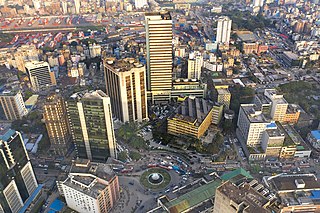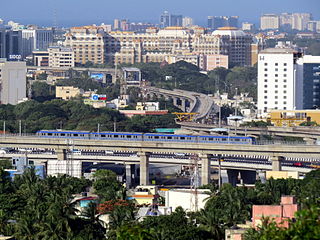
The economy of Cambodia currently follows an open market system and has seen rapid economic progress in the last decade. Cambodia had a gross domestic product (GDP) of $28.54 billion in 2022. Per capita income, although rapidly increasing, is low compared with most neighboring countries. Cambodia's two largest industries are textiles and tourism, while agricultural activities remain the main source of income for many Cambodians living in rural areas. The service sector is heavily concentrated on trading activities and catering-related services. Recently, Cambodia has reported that oil and natural gas reserves have been found off-shore.
The mixed economy of Sri Lanka was worth $84 billion by nominal gross domestic product (GDP) in 2019 and $296.959 billion by purchasing power parity (PPP). The country had experienced an annual growth of 6.4 percent from 2003 to 2012, well above its regional peers. This growth was driven by the growth of non-tradable sectors, which the World Bank warned to be both unsustainable and unequitable. Growth has slowed since then. In 2019 with an income per capita of 13,620 PPP Dollars or 3,852 (2019) nominal US dollars, Sri Lanka was re-classified as a lower middle income nation with the population around 22 million (2021) by the World Bank from a previous upper middle income status.

The economy of Bangladesh is a major developing market economy. As the second-largest economy in South Asia, Bangladesh's economy is the 35th largest in the world in nominal terms, and 25th largest by purchasing power parity. Bangladesh is seen by various financial institutions as one of the Next Eleven. It has been transitioning from being a frontier market into an emerging market. Bangladesh is a member of the South Asian Free Trade Area and the World Trade Organization. In fiscal year 2021–2022, Bangladesh registered a GDP growth rate of 7.2% after the global pandemic. Bangladesh is one of the fastest growing economies in the world.

The textile industry is primarily concerned with the design, production and distribution of textiles: yarn, cloth and clothing. The raw material may be natural, or synthetic using products of the chemical industry.

Fast fashion is the business model of replicating recent catwalk trends and high-fashion designs, mass-producing them at a low cost, and bringing them to retail quickly while demand is at its highest. The term fast fashion is also used generically to describe the products of this business model, particularly clothing and footwear. Retailers who employ the fast fashion strategy include Primark, H&M, Shein, and Zara, all of which have become large multinationals by driving high turnover of inexpensive seasonal and trendy clothing that appeals to fashion-conscious consumers.

Tamil Nadu has the second largest state economy in India. The state also hosts the highest number of factories in the country. The state is 48.40% urbanised, accounting for around 9.26% of the urban population in the country, while the state as a whole accounted for 5.96% of India's total population in the 2011 census. Services contributes to 54% to the gross domestic product of the state, followed by manufacturing at 33% and agriculture at 13%.
Clothing production is an important industry in Mauritius. Clothes are imported and exported in Mauritius. The clothing sector was on the verge of bankruptcy in 2008, but recovered. The sector employed 67,174 people in 2007 and made 1.45 billion dollars in revenue that same year.

The textile and clothing industries provide a single source of growth in Bangladesh's rapidly developing economy. Exports of textiles and garments are the principal source of foreign exchange earnings. By 2002 exports of textiles, clothing, and ready-made garments (RMG) accounted for 77% of Bangladesh's total merchandise exports. Emerging as the world's second-largest exporter of ready-made garment (RMG) products, Bangladesh significantly bolstered employment within the manufacturing sector.
Qualifying industrial zones (QIZs) are industrial parks that house manufacturing operations in Jordan and Egypt. The QIZ program was introduced in 1996 by the U.S. Congress to stimulate regional economic cooperation. Goods produced in QIZ-designated areas in Egypt, Jordan and the Palestinian territories can directly access U.S. markets without tariff or quota restrictions, subject to certain conditions. To qualify, goods produced in these zones must contain a small portion of Israeli input. In addition, a minimum 35% value to the goods must be added to the finished product. The idea was first proposed by Jordanian businessman Omar Salah in 1994.

MAS Holdings is a Sri Lankan apparel manufacturer. The company was founded in 1987 by Mahesh, Sharad and Ajay Amalean. MAS Holdings began as an underwear manufacturer and later diversified into sportswear, performance wear and swimwear.

Hayleys PLC, founded in 1878, is a multinational and diversified conglomerate company in Sri Lanka with business spanning over 16 sectors, catering to 70 markets worldwide. Hayleys accounts for approximately 4.2% of Sri Lanka's export income, and 3.9% of the country's tea and 4.5% of its rubber production. With over 30,000 employees, Hayley was also the first listed entity in the country to surpass annual revenue of US$1 billion in Fiscal Year 2017/18. The company operates over 16 business sectors: eco-solutions, hand protection, purification, agriculture, consumer and retail, leisure, textile manufacturing, construction materials, plantations, industrial solutions, power and energy, transportation and logistics, BPO, tea exports, projects and engineering, and investments and services. Hayleys comprises over 130 business units and subsidiaries, nine of which are publicly listed in the Colombo Stock Exchange. In addition to Sri Lanka, Hayleys today has manufacturing facilities in Indonesia and Thailand and marketing operations in Australia, India, Bangladesh, Italy, Japan, Netherlands, UK and USA and its products are sold in 80 countries.
The textile industry in India, traditionally after agriculture, is the only industry in the country that has generated large-scale employment for both skilled and unskilled labour. The textile industry continues to be the second-largest employment generating sector in India. It offers direct employment to over 35 million people in the country. India is the world's second largest exporter of textiles and clothing, and in the fiscal year 2022, the exports stood at US$ 44.4 billion. According to the Ministry of Textiles, the share of textiles in total exports during April–July 2010 was 11.04%. During 2009–2010, the Indian textile industry was pegged at US$55 billion, 64% of which services domestic demand. In 2010, there were 2,500 textile weaving factories and 4,135 textile finishing factories in all of India. According to AT Kearney’s ‘Retail Apparel Index’, India was ranked as the fourth most promising market for apparel retailers in 2009.

Saffron Aviation, DBA Cinnamon Air is a Sri Lankan domestic airline, operating from a dedicated terminal at the Bandaranaike International Airport, Colombo to destinations around Sri Lanka. It commenced its daily scheduled operation in July 2013. Cinnamon Air’s fleet consists of two Cessna 208 Amphibian aircraft and one wheeled Cessna 208B Grand Caravan. Saffron Aviation (Pvt) Ltd. which manages Cinnamon Air is a joint venture between John Keells Holdings PLC (JKH), MMBL Leisure Holdings (Pvt) Ltd., and Phoenix Ventures Limited. The company slogan is Wings of Sri Lanka.

Clothing industry or garment industry summarizes the types of trade and industry along the production and value chain of clothing and garments, starting with the textile industry, embellishment using embroidery, via the fashion industry to apparel retailers up to trade with second-hand clothes and textile recycling. The producing sectors build upon a wealth of clothing technology some of which, like the loom, the cotton gin, and the sewing machine heralded industrialization not only of the previous textile manufacturing practices. Clothing industries are also known as allied industries, fashion industries, garment industries, or soft goods industries.

NASSA Group of Industries was founded in 1990 by Nazrul Islam Mazumder. It is one of Bangladesh's largest industrial conglomerate
The Sri Lanka Institute of Nanotechnology is a Sri Lankan research institute specialising in the field of nanotechnology. It was incorporated in 2008 as a public-private partnership between the Government of Sri Lanka and five private companies, and is notable for being the first public-private research institute in the country.
Martin Trust also known as Marty Trust was an American business magnate entrepreneur and philanthropist who was also known for his contributions to the economy of Sri Lanka by modernising the country's apparel industry. He is also known as the 'father of the modern Sri Lankan apparel industry', as he was instrumental in making the country one of the global leaders in the apparel industry. He is still regarded as one of the pioneers of American fashion retail sector. He died on 12 September 2019 at his home at the age of 84 in Boston, US.

Brandix Apparel Limited is an apparel manufacturer headquartered in Sri Lanka. It is considered to be the leading apparel manufacturing firm in the country. The company has branches in the United States of America, United Kingdom, Australia, Singapore, Hong Kong, India, Bangladesh, Cambodia, Mauritius, and the Cayman Islands. Brandix has a crucial role in the Sri Lankan economy by being the main contributor to the Gross Domestic Production. It is the single largest employer in Sri Lanka's export sector and the highest foreign exchange earning company.

Teejay Lanka PLC formerly known as Textured Jersey Lanka is a knitted fabric manufacturer in Sri Lanka and is one of the constituents of the S&P Sri Lanka 20 Index of the Colombo Stock Exchange. The company received the award of the best textile exporter in Sri Lanka at the Presidential Export Awards in 2019 and ranked amongst the 100 most respected companies in the country by the LMD magazine. The company is a supplier to the brands such as Nike, PVH, L Brands, Marks & Spencer, Decathlon, Lidl, and Calzedonia.

Hela Apparel Holdings PLC branded as Hela Clothing is a holding company in Sri Lanka that is engaged in the apparel industry. The company supplies to a number of brands such as Tommy Hilfiger, Calvin Klein, and Michael Kors. Hela Apparel Holdings operates four design centres in Sri Lanka, the United States, France and the United Kingdom. The company have eleven manufacturing plants, seven in Sri Lanka, and two each in Ethiopia and Kenya. The company is one constituent of the S&P Sri Lanka 20 Index since June 2022.















